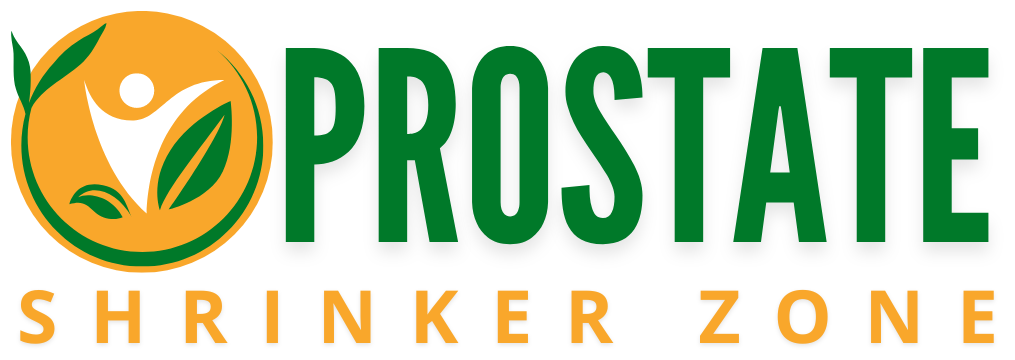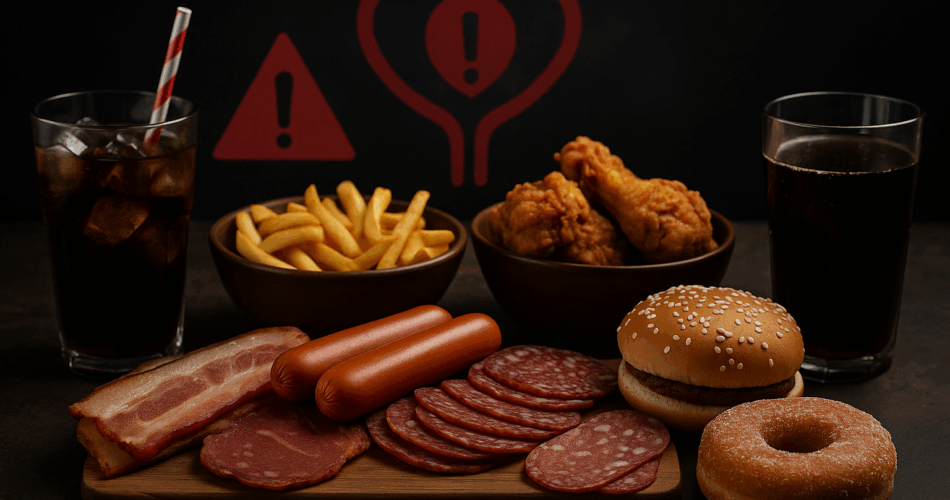Why Diet Matters for Prostate Health
Benign prostatic hyperplasia (BPH) and lower urinary tract symptoms (LUTS)—like frequent urination, urgency, weak stream, and night-time trips to the bathroom—often overlap with dietary triggers. Food choices can influence inflammation, metabolic health, hormonal signaling, and bladder irritation, all of which may affect how large the prostate becomes or how intense symptoms feel. The aim here is to spotlight common culprits and offer realistic substitutions.
What “Toxic” Means in This Guide
- Clarifying language: “Toxic” is used colloquially to mean “unhelpful for symptoms” rather than medically toxic.
- Individual variability: Responses vary. Some people tolerate moderate amounts of these foods with minimal symptoms; others notice strong effects.
- Evidence vs. hype: Where research is mixed, this guide says so—and emphasizes self-testing and balance.
How Food Can Influence BPH & Prostate Symptoms
- Inflammation: Diets high in refined fats/sugars can upregulate inflammatory pathways, potentially aggravating prostate tissue.
- Metabolic health: Insulin resistance, central weight gain, and metabolic syndrome correlate with higher BPH risk and worse LUTS in many studies.
- Hormonal context: Certain patterns of saturated fat and total energy intake can affect hormones that may influence prostate tissue.
- Bladder irritation: Spicy foods, alcohol, and acidic items can irritate the bladder/urethra, mimicking or amplifying symptoms.
1) Alcohol and Beer
Why It Can Aggravate Symptoms
Alcohol—especially beer—acts as a diuretic and bladder irritant. This can translate to more frequent urination, night-time awakenings, and a sense of incomplete emptying. Beer also brings carbohydrates that may worsen belly fat and insulin resistance when intake is high or routine.
Rule of thumb: The more frequent the drinking and the closer to bedtime, the higher the chance of nocturia and fragmented sleep.
Portion Guidance & Smarter Swaps
- Cap to ≤ 1 drink/day for many adults, with several alcohol-free nights each week.
- Favor alcohol-free beer, sparkling water with citrus, or herb-infused water in social settings.
- If choosing alcohol, avoid late-evening drinks; finish 3–4 hours before bed.
Pros
- Social enjoyment; red wine in small amounts offers polyphenols.
- Alcohol-free options increasingly taste good and aid adherence.
Cons
- Bladder irritation; diuretic effect; sleep fragmentation.
- Beer adds carbs; routine intake can affect belly fat and insulin resistance.
2) Spicy Foods
The Irritation Mechanism
Chili heat activates TRPV1 receptors, which can irritate the bladder and urethra in sensitive individuals. The result may be urgency, frequency, and burning sensations that mimic or amplify BPH symptoms.
Find a Personal Tolerance
Not everyone reacts the same. Many do fine with mild spice but notice issues with very hot peppers or spicy late-night meals. Pairing spice with yogurt-based sauces or milk can blunt irritation.
Pros
- Spices add flavor and can reduce salt dependence.
- Some spices (e.g., turmeric) are anti-inflammatory when heat is modest.
Cons
- Hot chilies may aggravate urgency/frequency in sensitive bladders.
- Late-night spicy meals can compound nocturia.
3) Fried Foods
Oils, Oxidation & Inflammation
Deep-frying exposes oils to high heat, forming oxidized lipids and sometimes trans fats, which can elevate systemic inflammation—a pathway tied to worse prostate and urinary outcomes.
Better Cooking Methods
- Air-fry, bake, grill, or sauté using olive or avocado oil at appropriate temperatures.
- If eating out, choose places that refresh oils regularly, and keep portions small.
Pros
- Satisfying taste and texture; occasional small portions can fit within an overall balanced plan.
Cons
- Oxidized fats and excess calories can raise inflammatory load and weight.
- Restaurant fry oils may be reused, increasing byproducts.
4) Soy Products
Whole vs. Ultra-Processed Soy
Soy is nuanced. Whole or fermented soy (edamame, tempeh, miso) can be part of a balanced plan. Confusion arises from isoflavones (phytoestrogens): despite myths, research often suggests neutral or potentially protective effects for prostate health when soy is eaten in traditional forms. The concerns in this “toxic” list target ultra-processed soy products that are high in sodium, additives, or refined oils, and eating them in excess.
Label Literacy & Portioning
- Prefer minimally processed soy; mind sodium (especially in faux meats, sauces).
- Aim for moderate portions and rotate proteins—fish, legumes, eggs, poultry.
Pros
- Affordable lean protein; fiber (in edamame/tempeh); may be neutral/protective in whole forms.
- Helps reduce reliance on processed red meat.
Cons
- Ultra-processed soy can pack sodium, additives, and refined oils.
- Overreliance on salt-heavy soy sauces or faux meats may aggravate blood pressure and fluid shifts that worsen nocturia.
Bottom line: The issue is form and frequency, not soy itself. Whole or fermented soy in moderation often works well; highly processed soy products are the ones to limit.
5) Refined Sugars
Insulin Resistance, Weight & BPH
Refined sugars spike blood glucose and insulin, promoting belly fat and metabolic syndrome—both linked with higher BPH risk and LUTS severity. Sugary drinks, desserts, and hidden sugars in sauces can quietly drive symptoms.
Dessert Strategies
- Swap soda/juice for sparkling water + lemon.
- Choose 70–85% dark chocolate (small square) or Greek yogurt with berries + cinnamon.
- Pair fruit with nuts to slow glucose spikes.
Pros
- Occasional small treats can be sustainable and satisfying.
- Dark chocolate (in moderation) offers polyphenols.
Cons
- Frequent refined sugar spikes drive weight gain and inflammation.
- Sweetened beverages strongly contribute to total sugar load.
6) High-Fat Dairy Products
Saturated Fat & Hormonal Context
High-fat dairy can raise saturated fat intake, which relates to inflammation and may influence hormonal signaling relevant to prostate tissue in some contexts. Some individuals also experience lactose intolerance, exacerbating GI distress and pelvic pressure.
Fermented/Lower-Fat Options
- Prefer yogurt or kefir (probiotics) and lower-fat milk/cheese.
- Try fortified plant milks (unsweetened) if dairy is poorly tolerated.
Pros
- High-quality protein, calcium, and vitamin D (when fortified).
- Fermented dairy may support gut health.
Cons
- High-fat options increase saturated fat; excess calories can add weight.
- Lactose intolerance may worsen pelvic discomfort and bloating.
7) Processed Red Meat
Nitrites, AGEs & Inflammation
Bacon, sausages, hot dogs, deli meats, and cured meats often contain nitrites/nitrates and can generate advanced glycation end-products (AGEs) when cooked at high heat—both tied to inflammatory processes. Chronic high intake can burden metabolic and vascular health, which often tracks with worse prostate symptoms.
Protein Alternatives
- Choose fish (especially fatty fish 2×/week), skinless poultry, eggs, and legumes.
- If eating red meat, prefer unprocessed, lean cuts in small portions and cook at moderate heat.
Pros
- Convenient, tasty protein; iron and B12 content.
Cons
- Additives and high-heat byproducts add inflammatory load.
- Often high in sodium and saturated fat; easy to overeat.
One-Week “Prostate-Friendly” Sample Menu
Guide, not gospel. Adjust for allergies, preferences, and health advice.
Day 1
- Breakfast: Greek yogurt, berries, walnuts, cinnamon
- Lunch: Quinoa bowl with roasted vegetables, chickpeas, olive oil-lemon dressing
- Dinner: Baked salmon, steamed broccoli, sweet potato
- Snack: Apple + almond butter
Day 2
- Breakfast: Oats with chia, pumpkin seeds, sliced banana (small), nut milk (unsweetened)
- Lunch: Turkey lettuce wraps, avocado, tomato, mustard
- Dinner: Stir-fried tofu (tempeh) with mixed veggies, brown rice, light tamari
- Snack: 70–85% dark chocolate (1–2 squares)
Day 3
- Breakfast: Veggie omelet, whole-grain toast
- Lunch: Lentil soup, side salad with olive oil
- Dinner: Grilled chicken, asparagus, barley
- Snack: Carrot sticks + hummus
Day 4
- Breakfast: Kefir smoothie (unsweetened) with spinach, blueberries, flaxseed
- Lunch: Sardine salad on whole-grain crackers, cucumber slices
- Dinner: Turkey meatballs (baked) with marinara, zucchini “noodles,” parmesan (light)
- Snack: Pear + handful of pistachios
Day 5
- Breakfast: Cottage cheese (low-fat) with pineapple chunks (small portion)
- Lunch: Black bean taco bowl with avocado, pico de gallo
- Dinner: Baked cod, green beans, quinoa pilaf
- Snack: Edamame (lightly salted)
Day 6
- Breakfast: Chia pudding (unsweetened plant milk), strawberries, sunflower seeds
- Lunch: Chickpea-tuna salad with olive oil, lemon, herbs
- Dinner: Roast chicken, Brussels sprouts, brown rice
- Snack: Orange + a few almonds
Day 7
- Breakfast: Steel-cut oats with cinnamon, pear slices, pecans
- Lunch: Farro tabbouleh with cucumber, parsley, tomato, olive oil
- Dinner: Shrimp and veggie skewers, wild rice
- Snack: Greek yogurt + cocoa + drop of vanilla (no added sugar)
Hydration Notes:
- Emphasize water and herbal teas during the day.
- Stop fluids 2–3 hours before bed to reduce nocturia, unless advised otherwise by a clinician.
Grocery List & Label Checklist
Prioritize:
- Fresh/frozen vegetables & fruits, whole grains (oats, barley, quinoa), legumes, nuts/seeds, olive/avocado oil, fish, lean poultry, eggs, unsweetened dairy or fermented dairy, unsweetened plant milks.
Limit/Watch:
- Processed meats, high-fat dairy, refined sweets, sugary drinks, fried foods, ultra-processed soy, late-night alcohol/spice.
Label Checklist:
- Added sugars: Aim for ≤ 5–7 g per serving in routine items.
- Sodium: Keep most packaged foods ≤ 140–200 mg/serving.
- Oils: Prefer olive/avocado over seed oils high in omega-6 for frequent use.
- Ingredient length: Shorter lists, recognizable ingredients.
Quick Lifestyle Boosters Beyond Food
- Daily movement: 7,000–10,000 steps where appropriate; add resistance training 2–3×/week.
- Pelvic floor support: Gentle Kegel-type work (as guided by a clinician or pelvic floor specialist).
- Sleep: Target 7–8 hours; avoid late meals/spice/alcohol that disrupt rest.
- Weight management: Even a 5–7% weight reduction (if overweight) may ease LUTS.
- Caffeine timing: Shift coffee/tea earlier in the day to curb nocturia.
Caution & Personalization
Diet is a powerful lever, but medical evaluation is essential if symptoms are significant (e.g., pain, blood in urine, fever, urinary retention, or rapid changes). Some supplements, herbs, or medications interact with diet and fluids. Individuals with kidney disease, diabetes, hypertension, or cardiovascular conditions should tailor these suggestions with their clinician or dietitian.
One size never fits all. The best plan is the one a person can follow—comfortably, safely, and consistently.
Smarter Food Choices, Calmer Prostate
Prostate symptoms often ebb and flow with everyday choices. The “toxic seven” here—alcohol/beer, spicy foods, fried foods, ultra-processed soy items, refined sugars, high-fat dairy, and processed red meats—share a common theme: inflammation, irritation, and metabolic load. By dialing them down, upgrading cooking methods, and rotating in lean proteins, whole plants, and fermented foods, many people report fewer night-time trips, steadier flow, and better energy. The winning move is experimentation with structure—try targeted swaps for two weeks, track symptoms, then fine-tune.
FAQs
1) Are spicy foods always bad for prostate health?
Not necessarily. Some people tolerate mild spice fine. Very hot chilies can irritate the bladder/urethra and mimic worse BPH symptoms. Start low, note responses, and avoid late-night spicy meals.
2) Is soy off-limits for enlarged prostate?
Whole or fermented soy (edamame, tempeh, miso) is generally reasonable for many people and can be neutral to beneficial. The concern is ultra-processed soy with high sodium/additives or relying on it excessively. Balance and form matter.
3) What’s the biggest dietary trigger for urinary frequency at night?
Late-evening alcohol (especially beer), caffeine, heavy fluids, and spicy/acidic meals commonly worsen nocturia. Stopping fluids 2–3 hours before bed and moving trigger foods earlier often helps.
4) Can cutting refined sugar actually change prostate symptoms?
Reducing refined sugar can improve insulin sensitivity, weight, and inflammation, which correlate with BPH and LUTS. Many people notice fewer nighttime awakenings after swapping sugary drinks and desserts for lower-sugar options.
5) If red meat is limited, how can protein needs be met?
Lean poultry, fish, eggs, legumes, Greek yogurt, and tempeh provide ample protein. If choosing red meat, prefer unprocessed, lean cuts in small portions, cooked at moderate heat and not daily.





